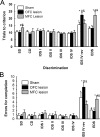Double dissociation of the effects of medial and orbital prefrontal cortical lesions on attentional and affective shifts in mice
- PMID: 18971455
- PMCID: PMC2657142
- DOI: 10.1523/JNEUROSCI.2820-08.2008
Double dissociation of the effects of medial and orbital prefrontal cortical lesions on attentional and affective shifts in mice
Abstract
Many neuropsychiatric diseases are associated with cognitive rigidity linked to prefrontal dysfunction. For example, schizophrenia and Parkinson's disease are associated with performance deficits on the Wisconsin Card Sorting Test, which evaluates attentional set shifting. Although the genetic underpinnings of these disorders can be reproduced in mice, there are few models for testing the functional consequences. Here, we demonstrate that an analog of the Wisconsin Card Sorting Test, developed in marmosets and recently adapted to rats, is a behavioral model of prefrontal function in mice. Systematic analysis demonstrated that formation of the attentional set in mice is dependent on the number of problem sets. We found that mice, like rats and primates, exhibit both affective and attentional sets, and these functions are disrupted by neurotoxic damage to orbitofrontal and medial prefrontal cortical areas, respectively. These data are identical to studies in rats and similar to the deficits reported after prefrontal damage in a comparable task in marmosets. These results provide a behavioral model to assess prefrontal function in mice.
Figures



References
-
- Brigman JL, Bussey TJ, Saksida LM, Rothblat LA. Discrimination of multidimensional visual stimuli by mice: intra- and extradimensional shifts. Behav Neurosci. 2005;119:839–842. - PubMed
-
- Brigman JL, Padukiewicz KE, Sutherland ML, Rothblat LA. Executive functions in the heterozygous reeler mouse model of schizophrenia. Behav Neurosci. 2006;120:984–988. - PubMed
Publication types
MeSH terms
Grants and funding
LinkOut - more resources
Full Text Sources
